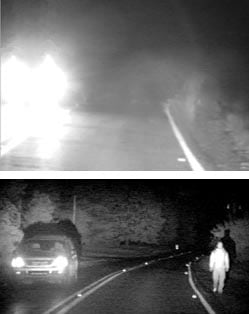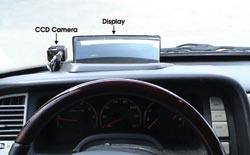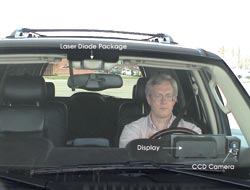Lasers help show the way even in difficult driving situations.
Jeffrey T. Remillard and Kenneth E. Nietering, Ford Scientific Research Laboratory; Michael A. Marinelli, Lear Corp.; and Sevugan Nagappan, Osram Opto Semiconductors Inc.
Driving becomes more difficult after sunset. Not only is visibility generally reduced, but an even more serious challenge on unlighted roads are the headlamps of approaching vehicles, which can dazzle a driver’s eyes. Night-vision systems can help drivers navigate in the dark, but to be of real help, they must be able to see both in the light and in the dark. They also must produce natural-looking images of the road, which is usually populated with animate and inanimate objects.

Nighttime driving conditions are enhanced by an NIR laser-based vision system. The naked eye is blinded by the headlights of an oncoming vehicle and can’t see the pedestrian (A). A thermal camera allows the driver to distinguish both the pedestrian and other vehicle but not the lane markings (B). The laser-based system, however, provides a clear view of the pedestrian, the vehicle and the markings (top).
Night-vision systems were introduced into the automotive market in the 2000 model year. The Cadillac DeVille that year used a thermal camera that was sensitive to the long-wave infrared part of the electromagnetic spectrum (the 8- to 14-μm band) along with a display that projected a virtual image of the road scene using the windshield.
Although this system excelled at detecting warm objects, such as pedestrians and animals, the image contrast was generally poorer for cool, inanimate objects, such as lane markings, signs and reflective road markings. Also, because automobile, windshields do not transmit long-wave infrared radiation, the camera had to be mounted on the outside of the vehicle, exposing it to the weather and, potentially, to damage from front-end collisions and road debris.
Lexus introduced the industry’s second night-vision system in 2002. Featured on the LX 470 sport utility vehicle, it had — instead of a thermal camera — an active night-vision system that used near-infrared illuminators and a CCD camera. Each illuminator consisted of an incandescent lamp filtered primarily to pass wavelengths longer than ~800 nm and designed to produce an angular distribution of light similar to that of a high-beam headlamp.

The CCD camera has high sensitivity in the near-infrared, and the QVGA liquid crystal display projects images to the driver using an aspheric-field mirror.
Because near-infrared radiation is not visible to the human eye, such a lamp can be used in the presence of approaching traffic without blinding the drivers (although the illuminator also emits a small amount of visible light).
The camera contained a long-pass filter with a transmission characteristic that matched the spectrum of near-infrared light emitted by the illuminator. A virtual image of the road scene was projected to the windshield for the driver’s use. In contrast to thermal night-vision images, those produced by an active night-vision system correspond more closely to what the driver sees with the naked eye. One disadvantage of this system was that the camera also was responsive to the near-infrared light emitted by the headlamps of oncoming vehicles, resulting in a washing out, or saturation, of the image. Although it works well on dark roads, its performance degrades in situations where a vision-enhancement system would be most valuable to the driver.

A laser-based night-vision system uses near-infrared wavelengths to improve visibility, even when the lights of oncoming traffic might blind a driver. Engineers set all of the components inside the vehicle to avoid weather- and hazard-induced failures that might occur if the laser system were externally mounted.
To improve the performance of vehicle-based active night-vision systems, researchers at Daimler-Benz AG in Ulm, Germany, developed an externally mounted diode laser as the near-infrared light source. Because the laser emits at essentially a single wavelength, a narrow bandpass filter can be used in the camera, which allows most of the laser light through while removing a large fraction of the near-infrared light from the headlamps of oncoming cars. This approach eliminates the image flaring that occurs in filtered-incandescent systems and allows the driver to have a clear view of the region near and behind oncoming traffic.
Placing the vision system on the exterior of a car would seem to be a natural design choice. However, from an engineering standpoint, it creates a nightmare because it is difficult to design an exterior lamp that is immune to water intrusion, which would wreak havoc with a laser and its power supply.
For this reason, engineers from Ford Motor Co. of Dearborn and Lear Corp. of Southfield, both in Michigan, designed and constructed a prototype system in which all components are positioned within the vehicle’s interior. Among the other advantages of this architecture are that it simplifies thermal management of the laser and its power supply; that the illuminator and camera apertures can be kept clear by placing them in the zone cleaned by the windshield wipers; that the number of common system components increases; and that the illuminator is protected from damage in front-end collisions.
The illuminator’s laser, which emits at ~810 nm, and its beam-forming optics, power supply and temperature management system are located in an overhead module. A lightguide collects and collimates the laser emission, and a holographic diffuser generates a beam pattern with horizontal and vertical spread angles (full width at the 1/e points) of 14° and 5.3°, respectively. A shroud that is sealed against the windshield prevents the laser light from being emitted into the passenger compartment. The illuminator meets the requirements of a Class 1 laser under all conditions.
Design fit
The laser diode package — Sirilas, from Osram Opto Semiconductors Inc. of Northville, Mich. — has a footprint similar to a TO263 transistor package and a volume of just 450 mm3, so it fits into the interior design very well. Unlike conventional high-power diode lasers that are mounted on a large, open heat sink, the laser bar is mounted using a proprietary hard solder technology on a premolded lead frame and sealed using a glass lens and protective metal cover.
The package, which has 16 emitters in a 6.4-mm laser bar, can handle up to 20 W in CW mode without any active cooling and has a wall-plug efficiency of 44 percent. It has a thermal resistance of 1.2 K/W and a slope efficiency of 1.05 W/A with the threshold at 8 A. The package also is capable of pulsed operation and has shown excellent lifetimes, even at an elevated temperature of 45° C.
The camera — provided by Sensors Technology America Inc. of Carrollton, Texas — is to the left of the display. It uses a 1/2-in. interline-transfer CCD, developed by Sony Corp. of America in New York City, that has high sensitivity in the near-infrared. The lens’ focal length of 20 mm provides an 18° horizontal field of view. A custom, narrow-pass filter was obtained from Barr Associates of Westford, Mass., and inserted directly in front of the CCD.
Finally, the image is projected to the driver from an aspheric-field mirror that forms a virtual image via a 3.8-in.-diagonal QVGA active-matrix liquid crystal display from Sharp Electronics Corp. of Mahwah, N.J. The mirror, which forms an adjustable eye box, does not affect or obstruct the driver’s view.
Spotting pedestrians in the dark
Both humans and night-vision systems have difficulty seeing clearly in dark conditions when an approaching vehicle shines its headlights. The prototype laser system forms a clear image of objects in the field of view, including pedestrians, that are not visible to the naked eye when opposing vehicle headlights are blinding. Thermal cameras can detect pedestrians but cannot see lane markings or other details with zero or low heat signatures. However, the laser-based night-vision system forms a clear image of all parts of a road scene.
This active night-vision system also can be used in conjunction with a threat-detection system that uses image-processing software to alert a driver to such hazards as potential collisions or lane departures. The same camera could be integrated with other systems to implement multiple safety features, increasing the likelihood that advanced photonics technology will keep us all safer behind the wheel.
Meet the authors
Jeffrey T. Remillard is a technical leader and Kenneth E. Nietering, a research scientist, at Ford Motor Co.’s Scientific Research Laboratory in Dearborn, Mich.; e-mail: [email protected] and [email protected].
Michael A. Marinelli is a program manager at Lear Corp. in Dearborn; e-mail: [email protected].
Sevugan Nagappan is a product marketing manager at Osram Opto Semiconductors Inc. in Northville, Mich.; e-mail: [email protected].